by Tim Clouter.
The club bought the wreck of the S.S. Bretagne in the late sixties; she is located 6 miles north of Berry Head & has been dived many times over the years.
| Lloyds Register # | HNMT 909 |
| Skipper | J. W. Johannesson -03 |
| Construction and Type | 1 deck and 1 spar deck. Steel, screw steamer, schooner. Water ballast: 1382 Tons Gross; 1305 Under Deck; 860 Net. |
| Builder | Nylands, Vaerksted, Christiania (Oslo) |
| Owner | Dmpskactleselsk, Ganger Rolf (Fred Olson) |
| Dimensions | Length 231.6 ft; Breadth 35.2 ft; Depth 14.7 |
| Port of Registry | Christiania, Norwegian |
| Engines Type | Triple expansion |
| No. of Cylinders | 3 1st Stage 16.5 Dia x 27″ Stroke 2nd Stage 44 Dia x 30″ Stroke |
| Nominal Horse Power | 106 |
| Makers Name | Nylands, Vaerksted, Christiania (Oslo) |
| Sail Area | 2000 sq. ft. approx. |
How she was wrecked : On the 10th of August 1918, during the last few months of the 1st World War, the Bretagne was about 4 miles N.E. of Hopes Nose, Devon, on passage from Barry to Rouen carrying a cargo of Welsh steam coal. The sea was calm in Torbay but there was a thick fog.
On an open bridge with no electronic instruments and only regular blasts on her steam whistle the crew kept a watchful eye in the surrounding fog.
Suddenly, at about 10:30am, the bow of another vessel, a French steamer the Rene Marthe, loomed out of the mist and struck into the starboard quarter, fatally damaging the Bretagne. When the ships came apart her fate was sealed. Despite the efforts of her crew, she slowly settled in the water and as the First Mate, Mr. Harry Watterson went back to get his possessions a wave slammed the door shut behind him and she sank with him still aboard! There she lay at 25 metres on a shale and sand bottom. At some point the navy swept the flimsy wooden bridge, funnel and masts which were a possible shipping hazard.
Finding the Bell.
In 1966 the Bristol Aeroplane Company Branch of the British Sub-aqua Club (as we were known then) shared a chartered pleasure boat with the Bristol No.3 branch and departed from Teignmouth to dive a wreck known then only as the ‘Teignmouth Coal Boat‘. The wreck was usually buoyed by a local trawler on the morning and as it was about 6 miles off Teignmouth finding the buoy was a bit hit and miss particularly without modern navigation aids. Often when about 2 miles out the coast disappeared and with it any shore marks so it was all eyes to locate the buoy. On this particular day the wreck was located without problem and diving commenced.
 The diving officer of that time (Ray Lewis) surfaced and asked for a rope as they had found the bell! A rope was passed and Ray disappeared with one end of it. After a few tugs it was hauled in and a barnacle encrusted lump, only vaguely bell shaped, was heaved up and over the side, shortly followed by Graham Llewellyn who had found it.
The diving officer of that time (Ray Lewis) surfaced and asked for a rope as they had found the bell! A rope was passed and Ray disappeared with one end of it. After a few tugs it was hauled in and a barnacle encrusted lump, only vaguely bell shaped, was heaved up and over the side, shortly followed by Graham Llewellyn who had found it.
The ‘crud’ was scraped off and the words,“Bretagne 1903 Christiania” were revealed, Christiania,now named Oslo, was the name of the Norwegian town where she was built. The Bretagne had been located and the ‘Teignmouth Coal Boat’ had her rightful name restored.
The bell was cleaned in a chemical bath at the local aero-engine works (to which our club is associated) and came up gleaming, weighing in at 44 lbs.
Buying the Wreck.
Graham Llewellyn and friend and dive buddy, John Toller, made extensive investigations to unearth more of the Bretagne’s history and to determine who the current owners were. It transpired that the Ministry for War Shipping had requisitioned her from her owners and as a consequence she was now the property of The Ministry of Transport. After some exchanging of letters and a little bargaining the wreck was purchased by Graham for the princely sum of £30. Graham then sold her on to our club at the same price, minus the bell – see this article for the latest on this.
Treasures from the Deep.
Graham and John had written to many people during their research and in doing so turned up copies of the crew list and ships logs. These revealed that the Bretagne had had as many as three collisions in 6 months – the last one proving fatal. Convoy duty with minimal navigation aids had posed many a problem for her captain of the day, J.W. Johannesson.
Over the next few years the club dived the Bretagne regularly. Portholes, a brass navigation aid known as a Pelorus (pictured with the bell above), the winch indicator door key, brass handrails, wash basins, china and an anchor light were just a few of the many items found. Amongst them, of particular interest was a brass nameplate marked, ‘R Pym, Devon‘. Checking the crew list, Richard Pym, was identified as one of two Naval gunners assigned to the Bretagne to man the 12 pounder gun (fitted upon requisition) to combat the threat of U Boats.
Finding a Crew Member.
At the time of finding the nameplate, Mr. Pym if still alive, would be in his late seventies. John Toller switched back into detective mode and endeavored to track him down. After many fruitless enquires it was thought that he was living somewhere in the Torbay area. A work colleague of John had a relation who was a postman in Torquay. With his help, Mr. Pym was at last located, living with his daughter in the outskirts of Torquay. Contact was established and a visit arranged whereupon Mr. Pym told his tale of the shipwreck.
The Gunners Story.
The noise of the collision was heard by the Torbay Boom Defence Vessel, which came out to investigate. Upon finding the stricken vessel she took off most of the crew leaving Pym, the First Mate and the Skipper aboard and took her under tow. The collision had left the Bretagne’s steering gear jammed to one side, her stern badly holed and she was taking on water fast.
The three remaining men tried desperately to uncouple the steering as she would not go in a straight line, but to no avail. As she started to founder and the water to lap over the deck the decision was taken to abandon ship. The First Mate however then decided to go below to rescue his possessions from his cabin. A wave slammed the door shut behind him and the Bretagne sank with him still inside. Pym and the Skipper stepped onto a lifeboat as she sank.
On landing at Torquay (his home town) Gunner Pym was not allowed to visit his home and put his parents mind to rest. Instead he was ordered to report to Devonport (Plymouth) as his No.1 uniform went down with the ship!
During 1970/71 the club decided to attempt to raise the anti-submarine gun from the stern of the wreck. Five divers attended weekend courses on ‘Basic Salvage‘ and ‘Explosives and Underwater Cutting‘ at Fort Bovisand, Plymouth. A lot of planning and preparation then followed which included:
- Survey of the site, determining the type and quantity of explosives required and estimating the buoyancy needed for the lift.
- Obtaining the required Explosives Certificate.
- Obtaining the appropriate explosives and arranging for them to be stored at a local quarry until needed.
- Construction of special cases, in accordance with regulations, for the safe transportation of the explosives.
- Provision of sufficient ropes, strops, oil drums and air cylinders for the lift.
- Building a special purpose heavy duty trailer to transport the gun back to Bristol.
- Chartering a suitable boat.
An Explosive Separation.
On the morning of Saturday 17th June 1972 all was set for the salvage operation to begin in earnest. The Police, Coast Guard and Receiver of Wrecks having been informed of the intentions, the explosives were picked up from the quarry and transported to Teignmouth where the other divers and boat, The Julia M, were waiting. After the 6 mile trip out, the wreck was soon located and the gun buoyed.
It was agreed to attempt to remove the gun from its mounting by placing a necklace of explosives around the top of the mounting, just below the trunnion supports. The charge was to be detonated from the surface. Although surface detonation was a more expensive method it ensured no one was in the water when the detonator was attached and lit. This safety aspect, it was felt, far outweighed any additional cost involved.
A 9lb necklace was made up from 4oz lumps of Plaster Gelignite strung on a few feet of Detonating Fuse. This was taken down to the gun and secured in position along with one end of a 150ft length of Detonating Fuse. The divers returned to the boat and after an especially careful check that no one was in the water the Detonator was attached to the surface end of the Detonating Fuse. The fuse was lit and cast off on a float to drift away from the boat on the tide.
After what seemed an eternity, but was in fact about 90seconds, the charge detonated and the sea boiled as the gasses released from the explosion reached the surface along with a large quantity of rust, silt and marine growth. Then stunned fish began to float on the surface, many of which ended up in the frying pan.
But had it worked? There was only one way to find out, so on went the diving kit and down went the divers to investigate. Yes indeed it had! The gun, now completely stripped of rust and marine growth was lying on the deck having been separated from its mounting. The explosive cleaning of the gun had revealed a brass plate declaring it to be a 12 Pounder with a weight of 12cwt. This hither too unknown information showed the estimates of the guns weight to be out and that sufficient buoyancy for the lift had not been brought, so this would have to wait for another day.
Raising the Gun.
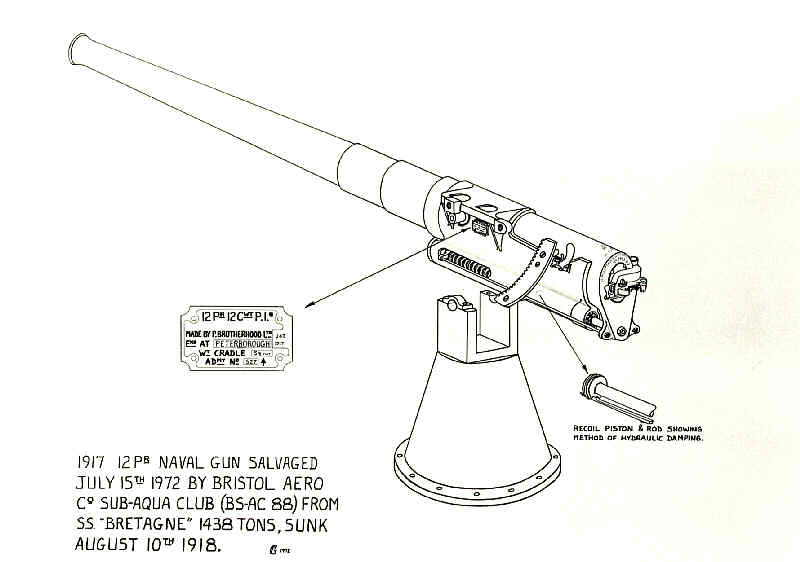 A return trip was planned for 1 week later to raise the gun but for various reasons, loss of drums, entanglement of winch wire and general deteriorating weather and visibility this only resulted in moving the gun off the deck and onto the seabed before the attempt was abandoned.
A return trip was planned for 1 week later to raise the gun but for various reasons, loss of drums, entanglement of winch wire and general deteriorating weather and visibility this only resulted in moving the gun off the deck and onto the seabed before the attempt was abandoned.
Due to a period of bad weather a further attempt could not be made until some weeks later on 15th July this time using the 60ft MFV Boymark (out of Torquay) as a diving platform. Oil drums and canisters were attached to the gun along with a 3 inch rope (which would be capable of taking the whole weight if necessary). Air was gradually added to the drums until the gun gently raised off the seabed and just hovered there. At this point the divers retreated to the wreck, some 40 feet away, and surfaced via the shot line.
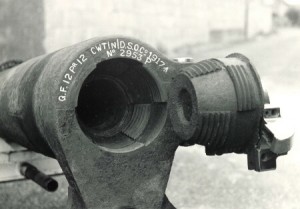 When the divers surfaced they found the boatman slowly pulling the gun up by hand until the expanding air took over and a few minutes later the drums broke the surface.
When the divers surfaced they found the boatman slowly pulling the gun up by hand until the expanding air took over and a few minutes later the drums broke the surface.
The gun was quickly secured to theBowmark and the slow 7 mile journey back to Torquay began. The next day, by use of the Harbour crane the gun was lifted up off the Bowmark and gently lowered onto the purpose built gun carriage – it fitted perfectly!
The weight of the trophy turned out to be 15cwt.
Gun and Gunner Reunited.
 To add a nice touch to what had been a very enjoyable weekend the gun was taken to the house of the then sprightly 79 year old Dick Pym, some 54 years after he’d last seen it on the fateful day of the sinking in 1918.
To add a nice touch to what had been a very enjoyable weekend the gun was taken to the house of the then sprightly 79 year old Dick Pym, some 54 years after he’d last seen it on the fateful day of the sinking in 1918.
“I never thought I’d see that bugger again!” he exclaimed, “I only ever polished it once”.
The gun had only ever been fired about 5 or 6 times and never in anger.
Diving the Bretagne.
The Bretagne is best dived at slack water but is diveable at most states of the tide. She lies upright on a sand and shingle bottom at 24-30 max metres, 18 metres to her deck, at position 50o29′ 30″ N 03o22′ 42″ W (*GPS), with her bow pointing south-west.
Small boats can be launched from Teignmouth, Brixham, Torquay or Paignton or you can do as our club do and dive her from a hard boat. We recently had a very enjoyable days diving from the ‘Kachelle‘ booked via Teign Diving Centre.
The Bretagne is very popular with anglers so watch out. A while back, one of our divers was very nearly pulled to the surface but for her buddy cutting the line. Neither she nor her computer were happy about the affair especially as, as a precaution she had to miss her second dive. The oblivious angler must have had quite a tale to tell about ‘the one that got away’ on that day.
The decks are pretty rotten, full of holes, collapsing and buckling so watch the sharp edges. The holds are badly silted up so take extreme care if you enter them. Also, avoid picking up wedges of phosphorous which are occasionally found amidships. They will burst into flame on exposure to air.
If you find any artifacts on her please remember that all wrecks belong to someone – and this one belongs to us. She’s now getting very old and frail so please do not remove or disturb anything (other than silt) from her.
* The co-ordinates given are GPS using WGS72 datum.
-
Why not download, print and laminate this free guide card and take it with you on your dive? It will help you find your way around.
Other Bretagne Links.
Stewart Butterfield (who was the inspiration for this page and who wrote the bulk of it) has written a subsequent article entitled,Diving the Bretagne. It describes dives both in the past and more recently. It also includes pictures of some of the other artifacts recovered.
The Bretagne was featured a while back by Diver Magazine as number 45 in the 100 best UK wreck dives. This link will take you to the article.
More recently, a three page article by John Liddiard which included a guided tour dive and an artists impression was featured in the November 2000 issue of Diver Magazine. This link will take you to that article.
Please note that there have been some changes to these links and both have now had to be modified to go to the same place.
Laurence Breeze, Webmaster October 2008.
My thanks go to Stewart Butterfield who provided the main picture and most of this information, and to Frank Rogers for additional photographs.
I hope this background information will enhance your enjoyment if you plan to dive on the Bretagne. If you have dived her (ever or recently) and have any comments or further information why not contact us.
Safe diving.
Last updated on: 24-June-2001 and on 29 January 2013
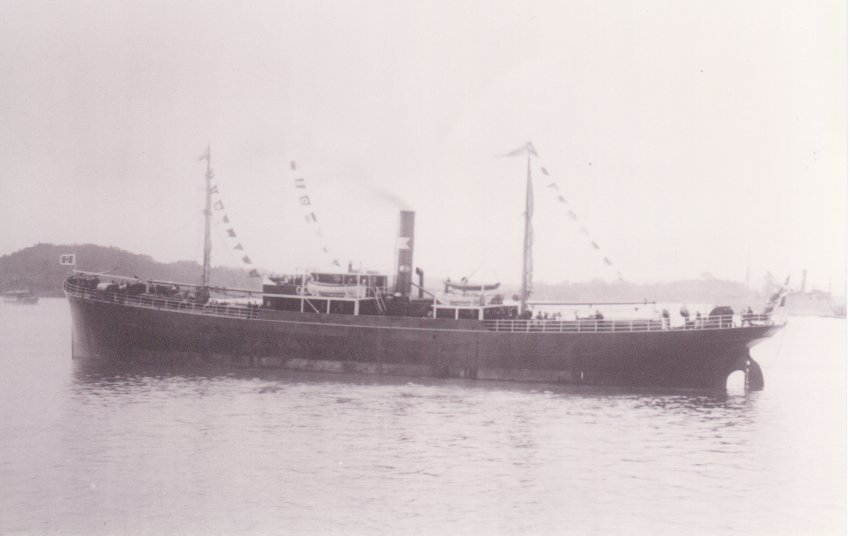
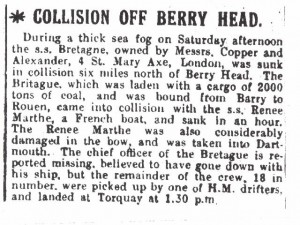
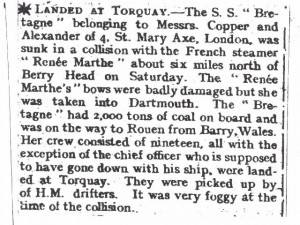
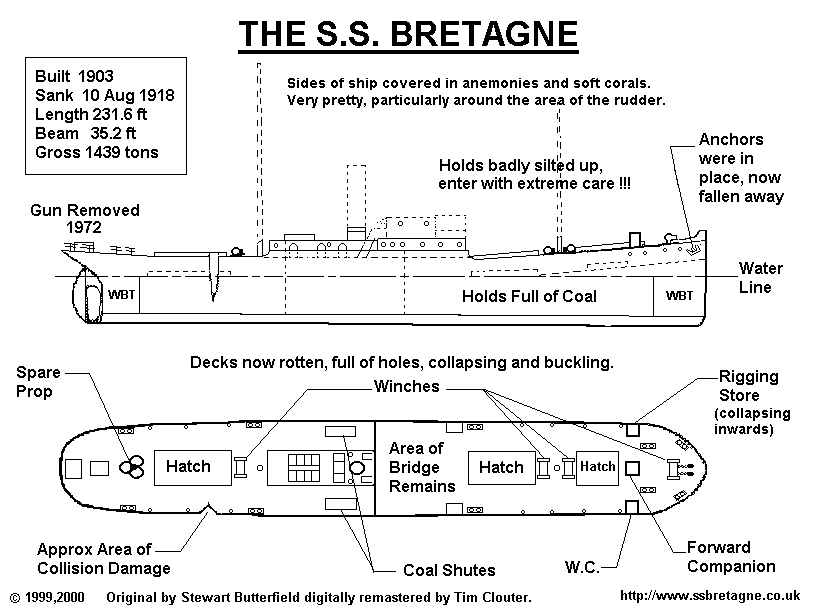



Just read your article on the wreck, the gunner happens to be my grandfather Richard Pym,my mother and I lived with him and my grandmother as my father was killed in W W 2. His only living daughter Maureen Taylor resides in Southampton,also he has a grandson Steven Gale who works or did ? For BAs. I remember the time well with the gun, he never stopped talking about it.
I well remember Dick Plym, and when we towed the gun round to show him. Actually I was the one who took the picture of Peter, Graham and Dick, (with Peter’s camera).